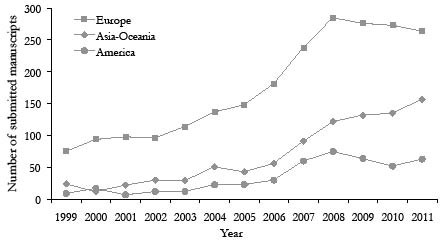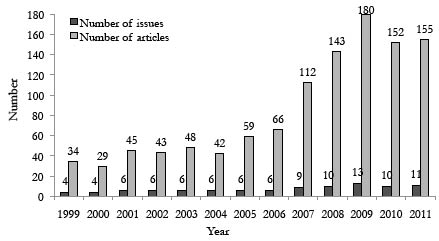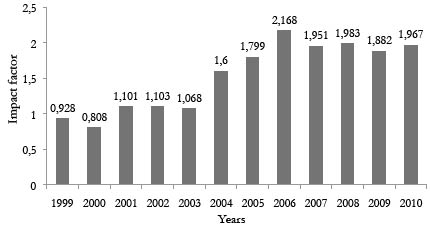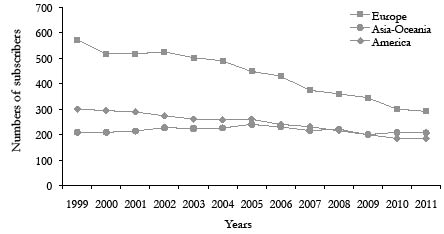JOURNAL OF REHABILITATION MEDICINE: LOOKING BACK AT 13 YEARS
AS EDITOR-IN-CHIEF
JOURNAL OF REHABILITATION MEDICINE: LOOKING BACK AT 13 YEARS
AS EDITOR-IN-CHIEF
Journal of Rehabilitation Medicine (JRM) was first published in 1968 as Scandinavian Journal of Rehabilitation Medicine (SJRM) by the late Professor Olle Höök, who also created the Swedish non-profit Foundation for Rehabilitation Information, which owns SJRM-JRM. The Foundation also disseminates information in the rehabilitation field, through arranging and supporting symposia and lectures. The journal initially comprised 4 issues per year. Published subjects and authors for the period up to 1993 have been summarized previously by Olle Höök (1). Manuscript submissions were initially almost exclusively from Scandinavia; however, by 1996 the proportion of contributions from outside Scandinavia had increased to more than 50%. The journal fairly quickly became internationally known, attracting subscribers from many parts of the world.
After being involved with SJRM for many years, as author, reviewer and advisor, I became Editor-in-Chief of the journal in 1999. Soon after that, in collaboration with the Board of the Foundation for Rehabilitation Information, the journal began to strengthen its international contacts further and to increase in size. Thus, from 2001 the name was changed to Journal of Rehabilitation Medicine. At the same time it also became the official journal of the European Union of Medical Specialists (UEMS) European Board of Physical and Rehabilitation Medicine (EBPRM). We appreciate the constructive collaboration we have with this organization.
In 2006, JRM became the official journal of the International Society of Physical and Rehabilitation Medicine (ISPRM), and this has been of importance for strengthening our contacts with research in physical and rehabilitation medicine (PRM) all over the world and has provided the opportunity to publish conceptual and strategic papers in the field of PRM. In 2006, JRM also became the official journal of the European Academy of Rehabilitation Medicine (EARM). From 2009 JRM has been published in association with the European Society of Physical and Rehabilitation Medicine (ESPRM) and, from 2010 also in association with the Asia-Oceanian Society of Physical and Rehabilitation Medicine (AOSPRM) and the Canadian Society of Physical Medicine and Rehabilitation (CAPM&R). These associations have lead to JRM publishing abstracts from the congresses held by these organizations as journal supplements, and have contributed to further contacts, resulting in the submission of papers from areas of the world represented by these organizations. Finally, the newly created Baltic and North Sea Forum for Physical and Rehabilitation Medicine (BNFRM) has selected JRM to be published in association with its organization and to publish abstracts.
The number of submitted manuscripts has increased over the period 1999–2011, especially since 2006 (Fig. 1). Since 2007 the number of manuscripts from Asia-Oceania has increased steadily, and the proportion of manuscripts from Europe, has thus correspondingly decreased somewhat. The marked increase in the number of submitted manuscripts, of the order of 247% between 1999 and 2006 and 181% between 2007 and 2011, has resulted in an increased number of published manuscripts, and an increase in the number and size of issues (Fig. 2). The number of issues increased from 4 in 1999 to 6 during 2001–2006, then to 10–13 during 2008–2011, including 1–3 Special Issues in some years, not mentioning the number of Supplements. The number of pages increased from 64 in 1999 to 96 from 2007 onwards. With manuscripts being of consistently high quality, the rejection rate has been rather constant, of the order of 65% from 1999. Thus, the change in numbers of published manuscripts has followed a similar pattern to that of submitted manuscripts.

Fig. 1. Number of manuscripts submitted to Journal of Rehabilitation Medicine during 1999–2011 from Europe, Australia plus Asia (Asia-Oceania) and America (including North and South America).

Fig. 2. Numbers of issues and articles for Journal of Rehabilitation Medicine per year for 1999–2011.
The 2-year impact factor increased successively from 1999 to 2006, and subsequently increased further, to the current level of around 2, which has been fairly constant for the last 5 years (Fig. 3). This impact factor is among the highest of all the journals in the field of PRM, as reported in several Editorials (e.g. 2, 3). The 5-year impact factor, which may be of more relevance for clinical journals, the peak in citations usually being at around 3–5 years and not 1–2 years after publication, has followed a similar pattern, but at a higher level, being of the order of 2.4–3.1. Other bibliometric quality indicators for journals have been presented and discussed, for example by Franchignoni & Muñoz Lasa (4), and commented on in an Editorial (5). The impact factor is of importance for attracting high-quality papers, as also is a reputation for a rapid handling time, although unfortunately we have not always been able to achieve this, for various reasons related to the peer review process.

Fig. 3. Two-year impact factor of Journal of Rehabilitation Medicine, 1999–2010.
It is, of course, difficult fully to evaluate the background to the very marked increase in submitted and, subsequently, published manuscripts over the last 5–6 years. It is, however, noteworthy that the impact factors have increased since 2005, and the fact that JRM became the official journal of ISPRM in 2006 and has since also been published in association with several other organizations, might have an important influence. It can be assumed that both of these factors are relevant for increasing interest in the submission of high-quality manuscripts to JRM from both within and outside Europe.
Broad categorization has been used to illustrate the distribution of topics in the journal from 2004 (Table I). For example, cerebral palsy is included in the topic “Other brain injuries”, and cardio-respiratory conditions, as well as methodological studies and conceptual reports, are included in the topic “Other studies”. The distribution of papers across topics has remained fairly constant. However, there has been a reduction in the relative (but not absolute) number of papers on “Musculoskeletal and pain conditions”. Overall, close to 60% of published papers fall into the area of “Neurological conditions”, whereas only around 20% of articles are on “Musculoskeletal and pain conditions”. The Editorial Board and Editors are attempting to address this imbalance by encouraging the submission of papers, including review papers, in the latter category. Compared with similar journals, a relatively large number of papers on conceptual aspects of rehabilitation, including policy papers, has been published, including the White Book on Physical and Rehabilitation Medicine in Europe, which was published in revised electronic form in 2009. A large number of papers on the application of the World Health Organization’s (WHO’s) International Classification of Functioning, Disability and Health (ICF), and methodological papers including the use of modern psychometric methodology (such as Rasch analysis) for instrument development and evaluation has been published. An increasing number of review papers has been published and has, during recent years, appeared in most issues. Also of interest are the publications on the topic ”Post-disaster rehabilitation”, initiated by ISPRM in recent issues in 2011 and 2012.
| Table I. Percentage distribution of topics for published articles in Journal of Rehabilitation Medicine for 2004–2011. For further explanation, see text | ||||||||
| Topics | 2004 | 2005 | 2006 | 2007 | 2008 | 2009 | 2010 | 2011 |
| Stroke | 20 | 25 | 29 | 29 | 25 | 21 | 22 | 22 |
| Other brain injuries, including cerebral palsy | 3 | 10 | 16 | 13 | 7 | 13 | 7 | 18 |
| Spinal cord lesions | 5 | 8 | 5 | 5 | 9 | 12 | 12 | 9 |
| Neuromuscular diseases, including polio | 10 | 5 | 10 | 7 | 7 | 3 | 8 | 8 |
| Musculoskeletal and pain conditions | 43 | 29 | 18 | 15 | 23 | 23 | 30 | 17 |
| Other studies, including other conditions and methodological studies | 20 | 22 | 22 | 31 | 29 | 28 | 20 | 26 |
| Total | 100 | 100 | 100 | 100 | 100 | 100 | 100 | 100 |
During 2010 and 2011 JRM trialled the categorization of scientific publications, as suggested by Stucki & Grimby (6). It was found that 26% were in the category Human functioning sciences, 34% Integrative rehabilitation sciences, 33% Biomedical rehabilitation sciences and engineering, 5% Professional rehabilitation sciences, and 1% Biosciences. Thus, all categories were represented. However, there are some difficulties in distinguishing clearly between the categories, and for some articles an alternative categorization may be possible, The Editorial Board has discussed ways of stimulating the submission of more manuscripts within Biosciences, with relevance to rehabilitation problems, but, thus far, we have unfortunately received only a few such articles.
We have given priority to Systematic Reviews, and have also published Educational Reviews in collaboration with the International and European organizations. The number of Letters to the Editor and Commentaries has increased over recent years; it is hoped that this trend will continue, resulting in constructive and on-going discussions about new ideas and research findings in PRM.
It is noteworthy that among the most downloaded articles since 2007, articles on musculoskeletal conditions predominate, comprising 11 of the 17 most downloaded articles (supplements with abstracts and The White Book excluded) (see www.medicaljournals.se/jrm). In the list of most cited articles from 1999 to 2011 (Table II) conceptual and ICF-oriented articles and methodologically oriented papers appear in the list of most cited papers. Randomized controlled trials (RCTs) are unfortunately rather few. The most cited article in SJRM-JRM over the years is overwhelmingly the paper by Fugl-Meyer and co-workers (7), which currently has 1125 citations in ISI’s Journal Citation Reports, with the article by Berg et al. (8) second, with 316 citations, both being papers describing methodology that is used extensively both in research and in clinical practice.
| Table II. The 20 most cited papers published in Scandinavian Journal of Rehabilitation Medicine and Journal of Rehabilitation Medicine during 1999–2011 | ||
| Articles | Publication year | Times cited |
| Cieza A, Geyh S, Chatterji S, et al. ICF linking rules: an update based on lessons learned. J Rehabil Med 2005; 37: 212–218. | 2005 | 223 |
| Cieza A, Brockow T, Ewert T, et al. Linking health-status measurements to the international classification of functioning, disability and health. J Rehabil Med 2002; 34: 205–210. | 2002 | 219 |
| Flansbjer UB, Holmback AM, Downham D, et al. Reliability of gait performance tests in men and women with hemiparesis after stroke J Rehabil Med 2005: 37: 75–82. | 2005 | 107 |
| Treleaven J, Jull G, Sterling M. Dizziness and unsteadiness following whiplash injury: characteristic features and relationship with cervical joint position error. J Rehabil Med 2003; 35: 36–43. | 2003 | 93 |
| Tesio L. Measuring behaviours and perceptions: Rasch analysis as a tool for rehabilitation research. J Rehabil Med 2003; 35: 105–115. | 2003 | 93 |
| Fugl-Meyer AR, Melin R, Fugl-Meyer KS. Life satisfaction in 18-to 64-year-old Swedes: in relation to gender, age, partner and immigrant status. J Rehabil Med 2002; 34: 239–246. | 2002 | 89 |
| Svensson E. Guidelines to statistical evaluation of data from rating scales and questionnaires. J Rehabil Med; 33: 47–48. | 2001 | 85 |
| Jette AM, Haley SM, Kooyoomjian JT. Are the ICF activity and participation dimensions distinct? J Rehabil Med 2003; 35: 145–149. | 2003 | 81 |
| Stucki G, Cieza A, Melvin J. The international classification of functioning, disability and health: a unifying model for the conceptual description of the rehabilitation strategy. J Rehabil Med 2007: 39: 279–285. | 2007 | 81 |
| van der Lee JH, Beckerman H, Lankhorst GJ, et al. The responsiveness of the action research arm test and the Fugl-Meyer Assessment scale in chronic stroke patients. J Rehabil Med 2001; 33: 110–113. | 2001 | 79 |
| Kosek E, Ekholm J, Hansson P. Pressure pain thresholds in different tissues in one body region – the influence of skin sensitivity in pressure algometry. Scand J Rehabil Med 1999: 31: 89–93. | 1999 | 67 |
| Kjellman GV, Skargren EI, Oberg BE. A critical analysis of randomised clinical trials on neck pain and treatment efficacy. A review of the literature. Scand J Rehabil Med 1999: 31: 139–152. | 1999 | 65 |
| Teixeira-Salmela LF, Nadeau S, Mcbride I, et al. Effects of muscle strengthening and physical conditioning training on temporal, kinematic and kinetic variables during gait in chronic stroke survivors. J Rehabil Med 2001; 33: 53–60. | 2001 | 65 |
| Haigh R, Tennant A, Biering-Sorensen F, et al. The use of outcome measures in physical medicine and rehabilitation within Europe. J Rehabil Med 2001; 33: 273–278. | 2001 | 62 |
| Lundeberg T, Lund I, Dahlin L, et al. Reliability and responsiveness of three different pain assessments. J Rehabil Med 2001; 33: 279–283. | 2001 | 60 |
| Peolsson A, Hedlund R, Oberg B. Intra- and inter-tester reliability and reference values for hand strength. J Rehabil Med 2001; 33: 36–41. | 2001 | 58 |
| Konstantinidou E, Koukouvou G, Kouidi E, et al. Exercise training in patients with end-stage renal disease on hemodialysis: comparison of three rehabilitation programs. J Rehabil Med 2002; 34: 40–45. | 2002 | 58 |
| Jette AM, Haley SM. Contemporary measurement techniques for rehabilitation outcomes assessment. J Rehabil Med 2004: 37: 339–345. | 2005 | 57 |
| Holmback AM, Porter MM, Downham D, et al. Reliability of isokinetic ankle dorsiflexor strength measurements in healthy young men and women. Scand J Rehabil Med 1999; 31: 229–239. | 1999 | 57 |
| Stucki G, Melvin J. The international classification of functioning, disability and health: a unifying model for the conceptual description of physical and rehabilitation medicine. J Rehabil Med 2007; 39: 286–292. | 2007 | 56 |
Among the challenges for PRM, for which the journal can provide support by publishing original articles as well as review papers, are the use and integration of current knowledge in biomedicine and neuropsychology in treatment procedures supporting the plasticity of the nervous system and various current approaches in pain management and rehabilitation. There is a need for more RCTs on rehabilitation interventions to be performed and published, and for other research strategies to be used to improve evidence-based clinical practice in PRM. Outcome measures must be developed and chosen on true scientific grounds, based on proper psychometric methodology. ICF has had a great impact in PRM, both conceptually and for structuring research design and study reports. We have given priority to these different aspects in JRM (3).
The total number of subscribers has decreased over the years, from 1,082 in 1999 to 682 in 2011; the decrease being especially marked for Europe, whereas the number of subscribers from Asia-Oceania has remained fairly constant (Fig. 4). The countries with the most subscribers are USA and Japan. A general trend of decreasing numbers of subscribers is common amongst many scientific journals. For JRM this may be due to several factors, including the journal being published electronically and the successive introduction of open access since 2007, as well as the general economic situation for universities and libraries. Various measures to increase the availability and citation rates of the journal may have been taken at the expense of the number of subscribers, highlighting strategic problems, and leading to the need to find new ways to support the journal economically.

Fig. 4. Number of subscribers to Journal of Rehabilitation Medicine, during 1999–2011 from Europe, Australia plus Asia (Asia-Oceania) and America (including North and South America).
The journal and its owner, the non-profit Foundation, have been much in favour of being as close as economically possible to open access. JRM now provides open access to all articles 6 months after publication and to some articles, such as invited Reviews, Special Reports, Letters and Commentaries, immediately. In addition, open access to a specific article can be paid for by the authors. In order to facilitate this process, some years ago we introduced a modest page charge and, from 2012, a submission fee.
To increase the journal’s international contacts, the number of members of the Editorial Board and of Editors from countries outside Europe has been increased successively, and should be increased further. At present, 4 out of 9 Associate Editors are from America, Asia and Australia and 8, 7 and 2, respectively, of the 48 members of the Editorial Board are from these regions.
When I took up the post of Editor in 1999, the journal had a half-time Editorial Secretary who was also working half time on another journal, Acta Dermato-Venereologica. The size of the Editorial staff has increased since then, and collaboration of the Editorial staff between these two journals has been very constructive, with positive experiences contributing to the development of both journals. I would therefore like to thank the Editor-in-Chief of Acta Dermato-Venereologica, Anders Vahlquist, for valuable collaboration during these years. This has been especially useful in the journal moving towards open access and for publishing without the involvement of a commercial publisher, as JRM has from 2007. The economic and practical effects of this arrangement have been impressive and could substantially contribute to the possibility of an increase in the size of the journal with only a marginal rise in subscription fees. At present the Editorial staff for JRM corresponds to approximately 3 full-time employees, with most of the staff being shared with the other journal. The Editorial Manager leads the daily editorial work and contacts, supported by an Editorial Secretary, and persons with special competence in IT (Web-Master), marketing and economics. We use an English language expert in the UK to copyedit the papers, and we print and distribute the journal through an external printing company. All other editorial work is completed in house. I would like to thank all personnel at the Editorial office for their highly productive collaboration and for their devotion to the work of making JRM as high quality as possible. I would also like to thank the Editorial Manager, Agneta Andersson, with whom I have worked since 1999; we have had many fruitful discussions and solved many practical and editorial problems together. For many authors and other contributors to the journal she has been an important “face” and symbol for the journal.
I would also like to thank all members of the Editorial Board, both present and former, for their excellent collaboration, for the time that they have spent without economic compensation on the journal, and for their friendship. JRM has worked with a large number of reviewers, most of them outside the Editorial Board, as mentioned in the final issue each year. I would like to thank all of them again for their work on the journal. I am also grateful to all the representatives of the different organizations for our valuable collaboration and the enjoyable times we have spent together at meetings and congresses.
We first set up the role of Associate Editor in 2005 and have now 9 Associate Editors plus an Advisory Co-Editor, Henk Stam, and Co-Editor, Bengt Sjölund, who have taken on some of the responsibility of the Editor-in-Chief during the last year; I am grateful to them all for their productive collaboration with the journal. As I am standing down from the position of Editor-in-Chief at the end of June, I would like to wish the new Editor-in-Chief Bengt Sjölund good luck and a long and fruitful collaboration with the team of Editors and Editorial staff. I hope that the increased scientific reputation of JRM will continue to attract excellent papers.
It has been a great challenge, an honour and an exciting time for me to serve JRM and the Foundation for Rehabilitation Information as Editor-in-Chief for the last 13.5 years.
REFERENCES
Göteborg and Uppsala June 2012
Gunnar Grimby
Editor-in-Chief
